23 Best Things to Do in Bucharest – and One I’d Avoid Right Now
In this guide you’ll find all the best things to do in Bucharest, the capital of Romania. It’s a vibrant city with a fascinating history and one of Europe’s most affordable capitals. I’ve included practical information and tips to help you make the most of your trip. Whether you’re drawn to grand avenues, history, a buzzing café scene or simply somewhere to let your hair down, this Balkan capital has plenty to draw you in and keep you entertained.
Planning a Trip To Bucharest? Here’s Where You’ll Find Things
Most recently visited in October 2025
And here’s some more from Romania on the One Small Bag if you’re interested:
This guide may include a few affiliate links. If you choose to buy something through one of them, I may earn a small commission (at no cost to you). Thank you for supporting One Small Bag and helping keep this resource ad-free and independent.
Is Bucharest Worth Visiting
Bucharest can get an unfair press. It may not charm you instantly, especially if you compare it to Romania’s storybook towns like Brașov, Sighișoara, or even Iași, the elegant eastern city near the Moldovan border. And if your first impression came via the less-than-welcoming Gara de Nord railway station, you could be forgiven for wondering whether it’s all worth it.
Our latest visit in October 2025 was our third, and this time we gave the city longer, time to wander and look beyond the surface. We left genuinely enchanted and already planning our return. Bucharest rewards curiosity. Come with an open mind and you’ll find a city that’s complex, creative, and far more captivating than its reputation suggests.
If you’re wondering what to see and do once you arrive, here’s my guide to the best things to do in Bucharest. It will take you on a journey which includes Bucharest’s Communist landmarks, it’s Belle Époque elegance which give it the nickname ‘Little Paris’, plus the lively nightlife of the Old Town.
Where to Stay in Bucharest
Bucharest’s six sectors (districts) fan out from the city centre like slices of cake, so don’t assume that staying in Sector 1 automatically means you’re central. Each one stretches from the middle to the outer edge of the city. These are the most relevant areas for visitors:
- Sector 1 – Piata Romana, Calea Victoriei, Herăstrău Park and out towards the airport
- Sector 3 – The historic centre, including the Old Town (Lipscani neighbourhood)
- Sector 4 – Palace of the Parliament and Piata Unirii
- Sector 6 – The residential neighbourhood of Cotroceni
We stayed in a modern, well equipped, self service room with kitchinette and bathroom just off Piața Romană, which turned out to be a perfect location – quiet, central, and right on the M2 metro line. On a previous visit in 2018 we stayed in the Old Town, which I’d personally avoid unless your main reason for visiting Bucharest is the city’s nightlife and red-light district.
Interactive map: Browse accommodation options in Bucharest -zoom in to compare prices and locations across the sectors.
Map Of Things To Do In Bucharest
To make it easy to explore, I’ve pinned all the sights from this guide on the map below. Click the top left hand corner, for a list of points, which are organised to match the sections and order of this article. So you can follow along section by section. Zoom, open, or save it to your own Google Maps for planning your route around the city.
Let’s start with Bucharest’s most striking legacy – its Communist landmarks and the grand architecture that defined an era.
Exploring Bucharest’s Communist Past
No visit to Bucharest is complete without glimpsing its Communist past, the ambition and scale, along with the secrecy that defined Nicolae Ceaușescu’s Romania. His vast Parliament building and his surprisingly homely villa are both worth your time. And you will almost certainly find yourself in Revolution Square, the place where the regime fell.
Palace of Parliament
The Palace of Parliament (Palatul Parlamentului) is impossible to ignore. It’s the world’s heaviest building and the second-largest administrative structure after the Pentagon. Conceived by Ceaușescu as a symbol of national pride (and his own authority), construction began in the 1980s. It equired entire neighbourhoods to be bulldozed and thousands of workers toiling in shifts around the clock.
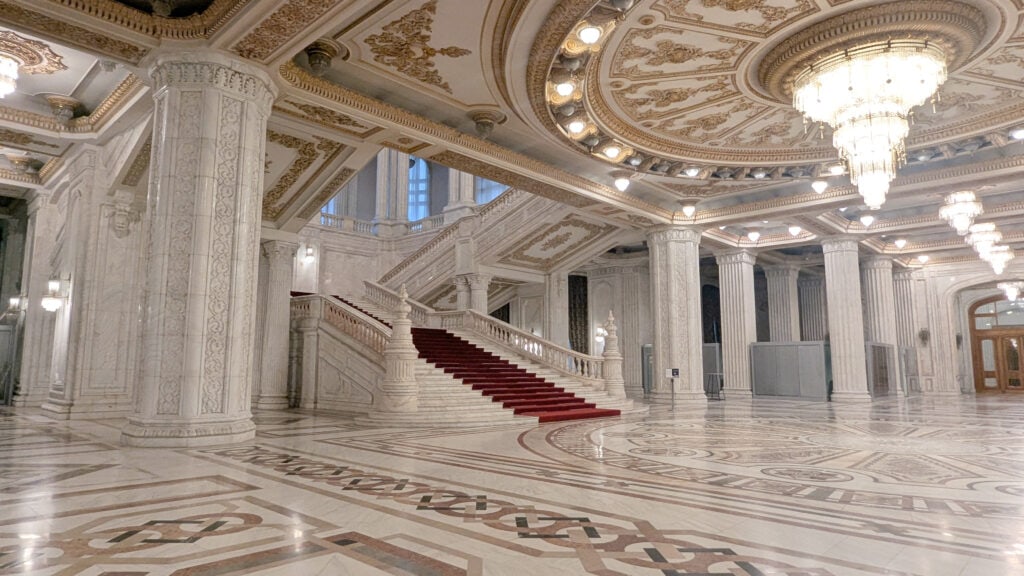
Today, visitors can tour its marble halls, sweeping staircases and crystal chandeliers – all the more striking when you remember the poverty outside its walls at the time it was built. You’ll need to book ahead and bring your passport for entry, but it’s worth it for the sheer audacity of the place and the view over Unirii Boulevard, once called “Victory of Socialism.”
If, like me, you left it too late to book direct, there are plenty of group tours who have separate ticket allocations, so you can still book last minute. We took this tour and can thoroughly recommend it
Ceaușescu’s Villa
Tucked away in a leafy northern suburb, the former home of Nicolae and Elena Ceaușescu offers a surprisingly intimate look at their private world. Unlike the stark concrete buildings associated with the regime, the villa (officially the “Spring Palace”) is filled with luxury – gold taps, Persian carpets, and an indoor pool lined with mosaics. Sadly photographs inside were strictly forbidden, so I can only show you the entrance inside and out.
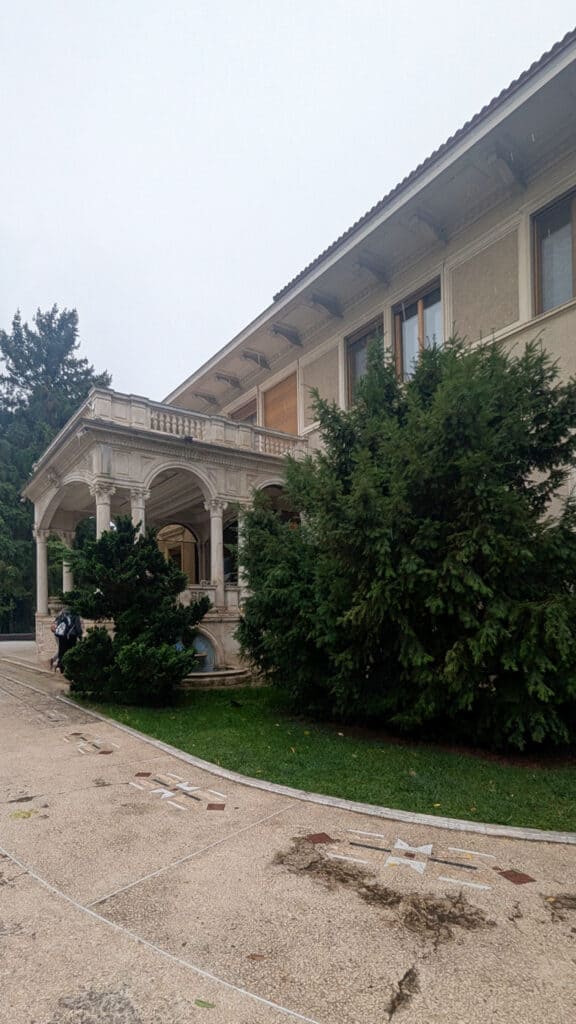

The guided tour is well-paced and genuinely fascinating, showing the contrast between the couple’s opulence and the shortages ordinary Romanians faced in the 1980s. You’ll see their personal wardrobes, gifts from world leaders, and even the family cinema. All preserved as they were left in 1989.
I asked how the house was still exactly as the Ceaușescu’s left it, given it was raided in the revolution of 1989. Apparently the security guards let people take the food and some of the clothes and removable items, leaving the actual building relatively unscathed.
Revolution Square
This unassuming square became the stage for the 1989 Revolution that ended Communist rule in Romania. It was here that Ceaușescu gave his final speech, expecting applause but instead facing a crowd that turned against him. Within days, he and his wife fled the capital – and the rest is history.
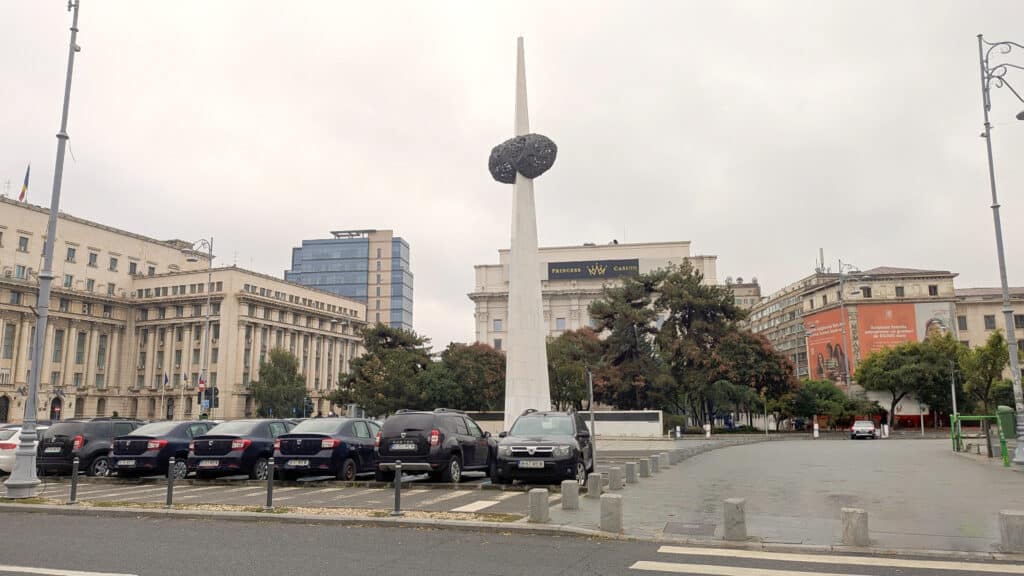
The square, today, is a place of reflection rather than spectacle. The stark “Rebirth Memorial” (sometimes dubbed the “potato on a stick” by locals) marks the moment of change. A stark reminder of how quickly history can pivot in just a few days.
After exploring Bucharest’s monumental Communist landmarks, it’s almost a relief to step away and enjoy life in the city today.
Bucharest’s Belle Epoque Charm
In the late 19th and early 20th centuries, Bucharest earned the nickname “Little Paris” for its grand boulevards, ornate architecture, and café culture. Today, fragments of that era still shine through. You won’t find a single “Belle Époque district” – the treasures are scattered. But I’ve included some of the best spots to admire the city’s old-world glamour.
Arcul de Triumf
Bucharest’s Arcul de Triumf stands proudly at the top of Șoseaua Kiseleff, modelled after its Parisian namesake. Originally built in wood to celebrate Romanian independence, the current stone version dates from 1936 and marks the northern gateway to the city.
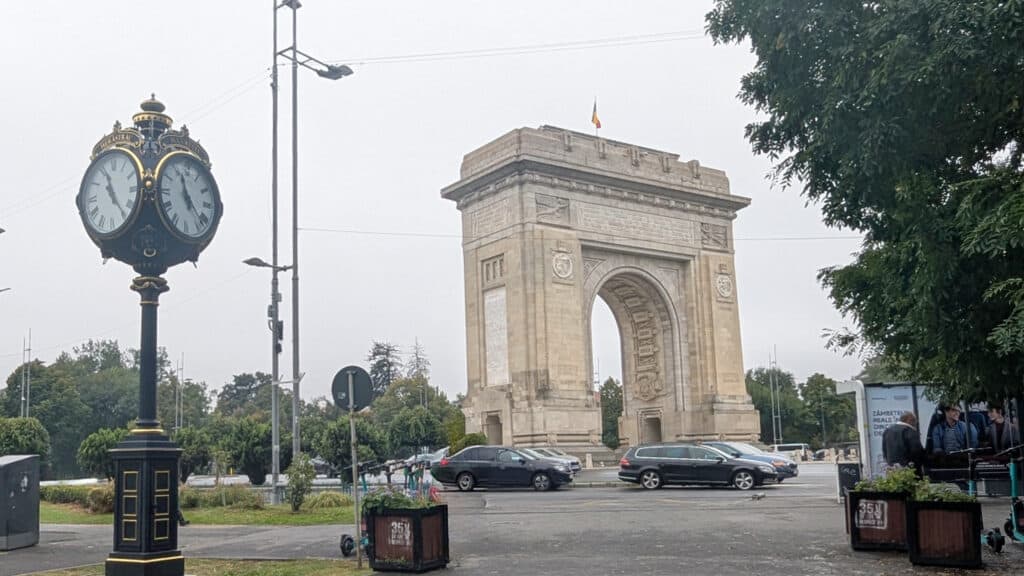
It’s a bit of a trek from the centre, but you can easily reach it by taking the M2 metro to Aviatorilor or hiring an e-scooter. On national holidays, the Arc opens for visitors, offering panoramic views across the city.
Pasajul Macca-Vilacrosse
Step beneath the glass canopy of the Macca-Vilacrosse Passage and you’ll feel like you’ve wandered onto a film set. Do look upwards to the beautiful dome and stained glass, Built around 1900, it once linked the old National Bank with the busy Lipscani area and housed luxury shops and cafés.
These days, it’s mostly filled with hookah lounges and cafés competing a little too eagerly for your attention. Expect a chorus of “please, sit here!” from the owners, but it’s still worth a quick detour for the architecture and atmosphere, especially in the early morning before the touts wake up.

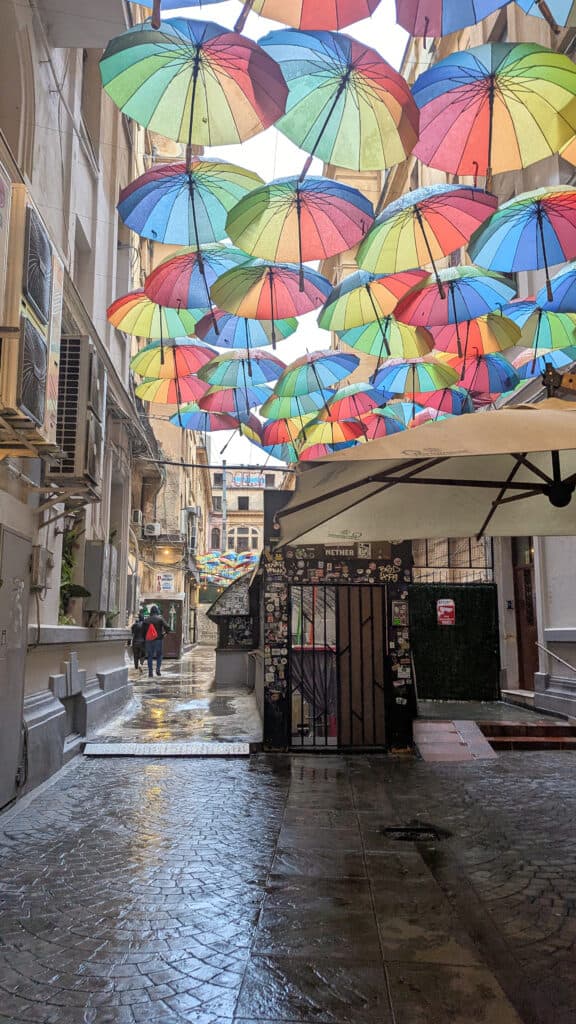
Umbrella Street
Hidden between two grand old façades near Calea Victoriei, Victoria Passage has become one of Bucharest’s most photographed walkways. The lane itself dates back to the late 1800s, but its fame comes from the canopy of multicoloured umbrellas strung above the passage. So it’s an obvious stop for your pictures for the Gram.
Hotel Capsa
Few places capture old Bucharest quite like Hotel Capsa, open since 1852 and still serving tea and cakes in a setting fit for royalty. Its mirrored salon, crystal chandeliers and impeccable service definitely take you back in time.
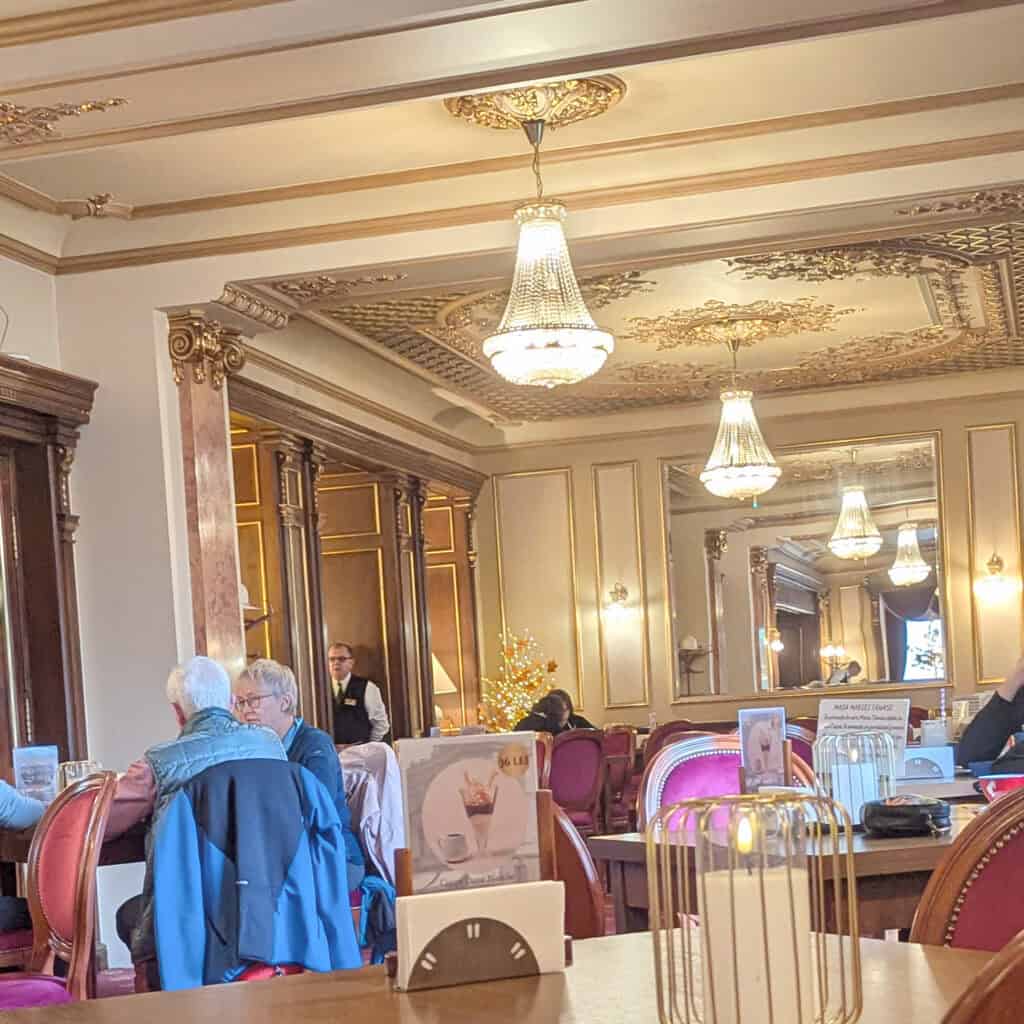


It’s definitely worth dropping in for a coffee or a slice of Joffre cake, ( chocolate roll) and a Bucharest classic named after a French general. We loved our stop here and would definitely recommend it.
CEC Palace and the Former Stock Exchange
If you’ve wandered this stretch of Calea Victoriei and wondered if you’re seeing double, you’re not alone. Facing one another across the street are two of Bucharest’s grandest façades. They are both domed, both early-20th-century showpieces, and, as we found, both responsible for confusion online.
On one corner stands the CEC Palace, built as Romania’s national savings bank (Casa de Depuneri și Consemnațiuni). It’s still the headquarters of CEC Bank today, which means its ornate glass-domed interior isn’t generally open to the public. Some travel sites wrongly call this the Stock Exchange Palace or claim it hides a market inside. It doesn’t. You can, however, admire the elaborate ironwork and grand entrance from the pavement.
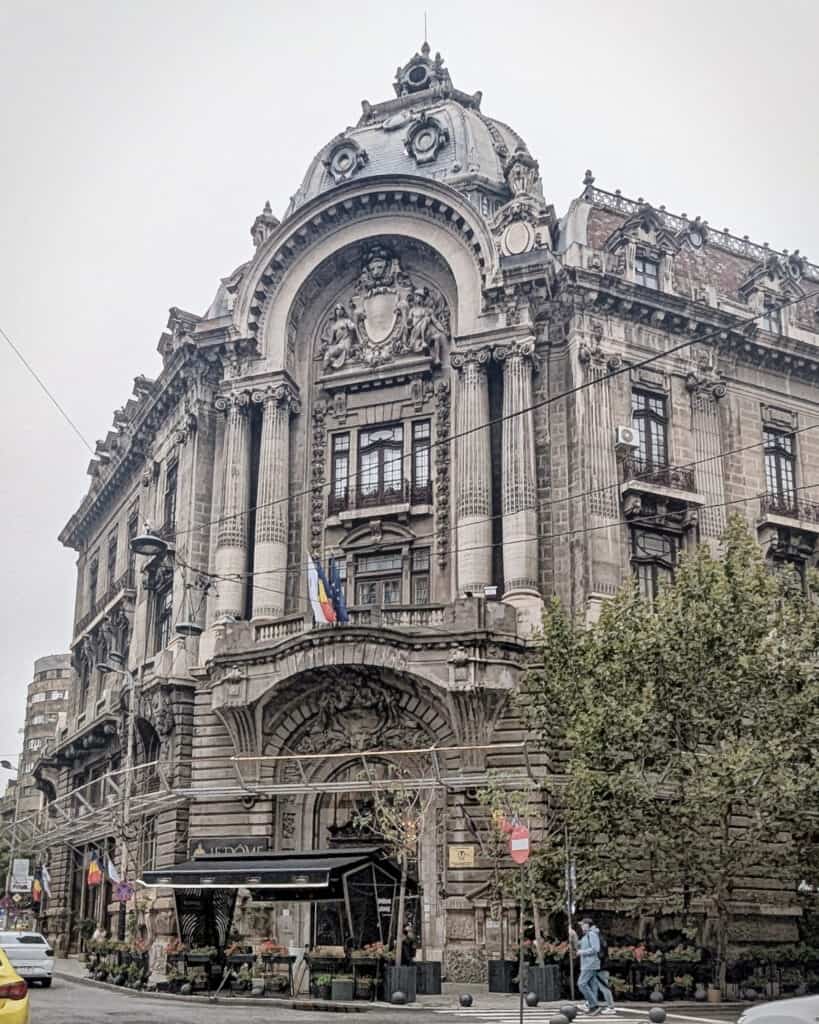
(now a restaurant)
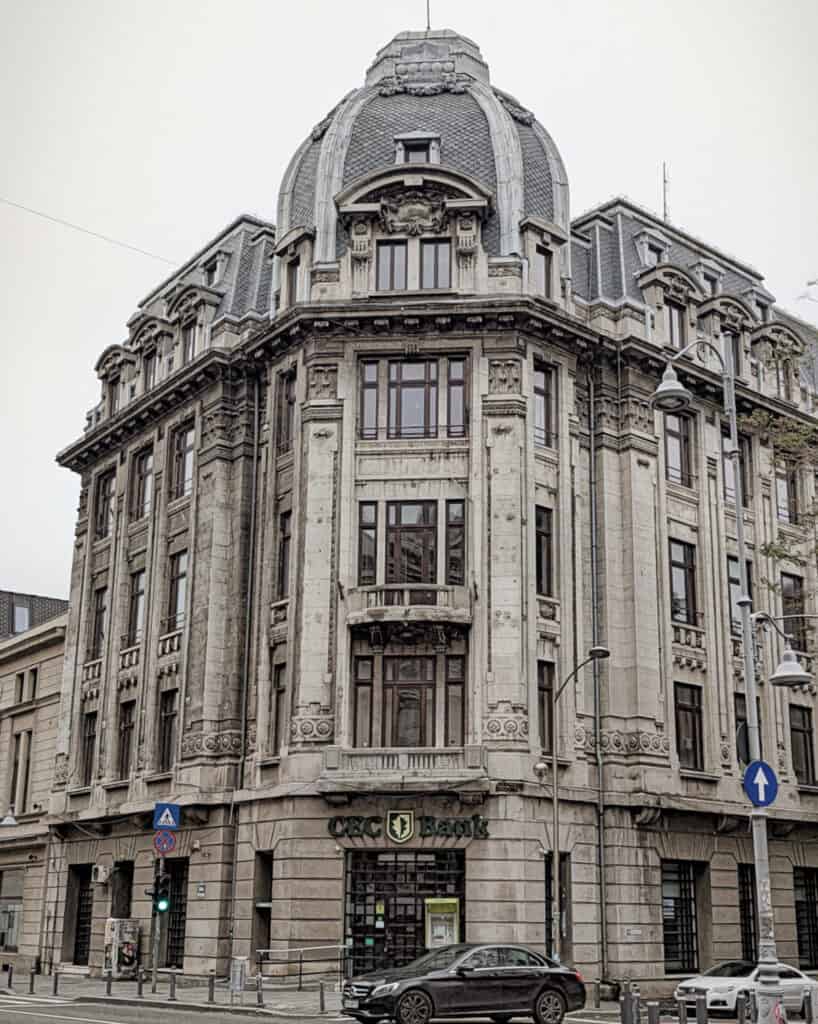
Directly opposite, is the former Stock Exchange Palace, completed for the Bucharest Chamber of Commerce. Now branded as Le Dôme, a marble-columned restaurant and event venue. Some older blogs mention “stalls” or “antique markets” inside, but I think that must be outdated. Today it hosts weddings and corporate receptions and no markets. Adding to the mix, a small budget hotel called NF Palace Old City Bucharest occupies part of the upper floors, reached through a separate side entrance – hence the conflicting reviews and map pins.
The Royal Palace and Art Museums
The Royal Palace sits at the end of Calea Victoriei, on the edge of Revolution Square. Inside are two main art collections, European Art in the left wing and Romanian Art in the right.
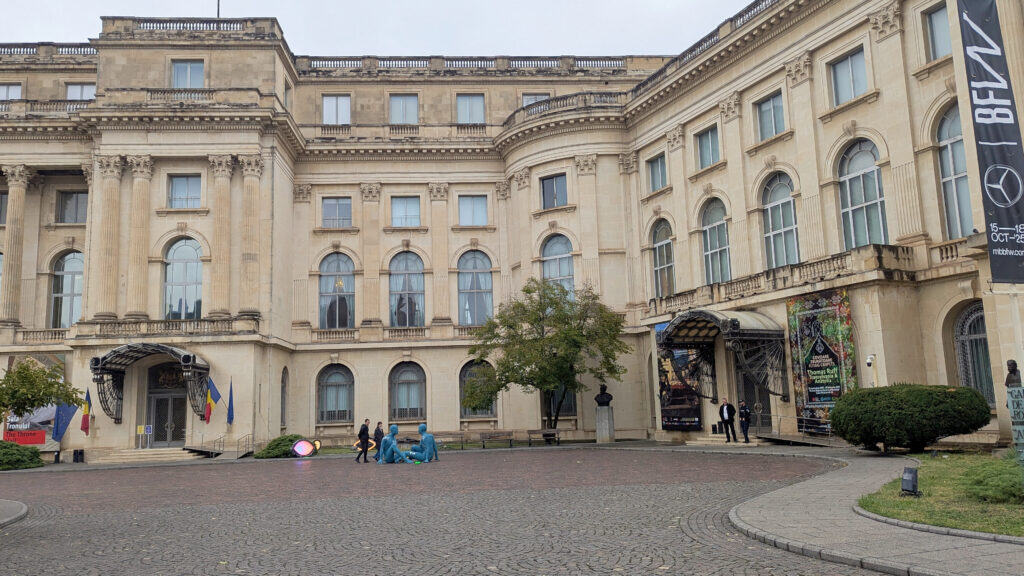
We bought tickets to the Romanian art gallery, hoping it might also include access to the grand royal apartments: the marble staircases, ballrooms and ceremonial halls. Sadly, it didn’t. Those require a separate guided tour, and opportunities are limited. Instead, we spent our time winding through the Romanian art wing. It’s huge, varied and genuinely impressive. If you’d like to see what lies beyond as well, here’s how to try to get access to the palace rooms.
- Contact: secretariat@art.museum.ro
- Reserve in advance: The museum asks visitors to get in touch at least seven days ahead for English-language or special guided tours.
- Be flexible: Access to the “palace rooms” is occasional and depends on staffing or events.
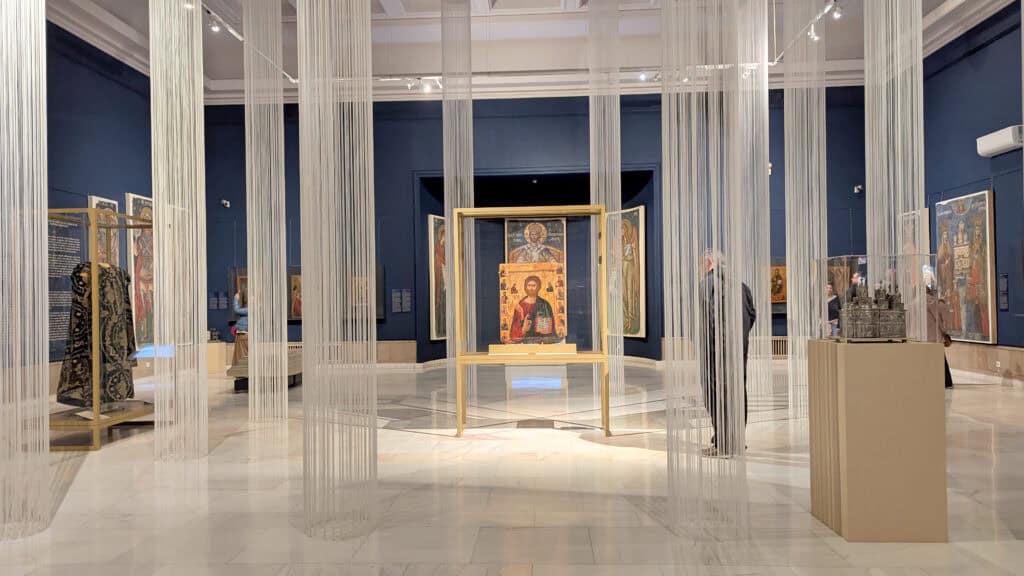
From the Royal Palace, it’s only a short walk to Cișmigiu Gardens, Bucharest’s oldest park.
Cișmigiu Gardens
Laid out in the mid-19th century by a Viennese landscape architect, Cișmigiu Gardens remains one of Bucharest’s most graceful public spaces. With winding paths, ornamental bridges and shaded benches. A peaceful pocket of old-world charm right in the centre of Bucharest.
From Cișmigiu, head back towards Calea Victoriei to see more of Bucharest’s Belle Époque architecture.
Other Highlights Along Calea Victoriei
Even if you don’t step inside, you can still enjoy some of Bucharest’s most elegant façades from the street. Keep an eye out for:
- Central University Library
- National Military Circle (Cercul Militar Național)
- National Museum of Romanian History
- National Bank of Romania
All of these lie within easy walking distance of one another
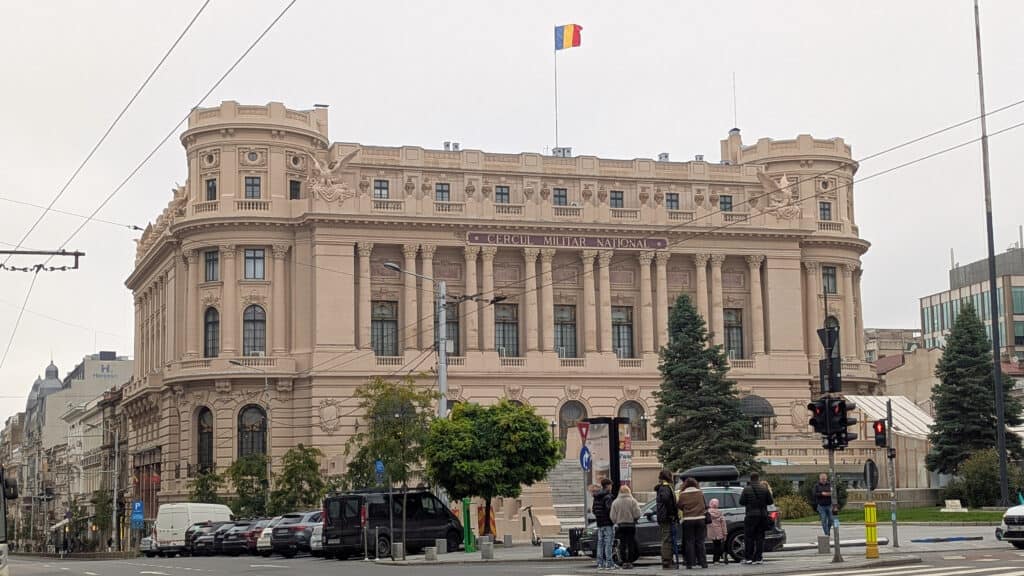
Walk south along Calea Victoriei and Bucharest begins to change. The polished façades and grand balconies give way to narrow lanes, small courtyards, and music drifting from open-fronted bars. The air feels livelier, less formal. This is where the Belle Époque fades into the Old Town, a jumble of history and nightlife that captures Bucharest at its most human.
🌍 Exploring this region?
Here are more ideas and nearby destinations worth adding to your itinerary:
• Best Day Trips from Bucharest: Castles, Mountains, the Black Sea and Cross Border Adventures
• Best Things to Do in Iași: Discover Romania’s Cultural Gem
• Chisinau to Bucharest Sleeper Train: Europe’s most Unusual Rail Journey
Bucharest’s Old Town
If Bucharest’s Belle Époque boulevards show its elegant side, the Old Town (Centrul Vechi) is where the energy kicks in. Cobbled lanes packed with bars, restaurants, and live music which spills onto the streets. It can feel a bit touristy, and there’s some hard selling from restaurant staff and a lingering red-light element that’s hard to miss. But tucked between the nightlife spots are some genuinely interesting historic corners, small museums, and courtyards that make this corner of Bucharest an essential part of your trip to Bucharest.

Here are some highlights which are well worth your time.
Cărturești Carusel
Cărturești Carusel is one of the most photographed spots in Bucharest. It’s a bookshop housed in a restored 19th-century bank building. Its swirling white balconies and central skylight give it a very distinctive appearance and make it instantly recognisable. It’s not suprising it’s an Instagram favourite.

The name translates as Carousel of Light, and it’s just as enchanting as it sounds, especially looking down from the top-floor café.
It was busy when we visited. It reminded me of another famous bookshop, Livraria Lello, in Porto, Portugal, we visited recently. That had timed tickets and was absolutely heaving. While Cărturești Carusel wasn’t quite that busy, and a little bigger too, it did feel to me like it was heading the same way. So if you want to see it, I’d go sooner rather than later and go early or late to avoid busy times.
Caru’ cu Bere
No visit to Bucharest is complete without a meal (or at least a beer) at Caru’ cu Bere, the city’s most iconic restaurant. Open since 1899, it was originally a beerhouse for German merchants and quickly became the social hub of the city. Inside, the Neo-Gothic hall is a riot of painted ceilings, stained glass, and carved woodwork – part Habsburg tavern, part Transylvanian fairy tale.
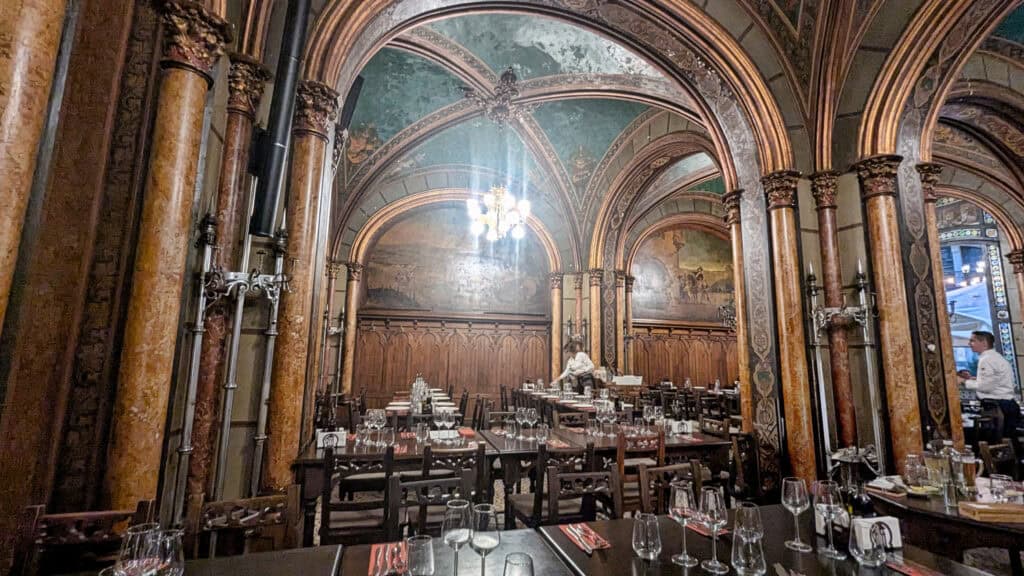
The menu leans traditional and hearty, so this is one of your best opportunities to try a classic Romanian dish, which is exactly what we did.

This was a sharing plate of Pork knuckle with Polenta, one of the signature dishes at the restaurant. It did not disappoint.
Hanul cu Tei
A short walk away, Hanul cu Tei is one of the last surviving merchant inns (hanuri) in Bucharest. Built in the 1830s, it once offered lodging and storage for traders passing through the city.
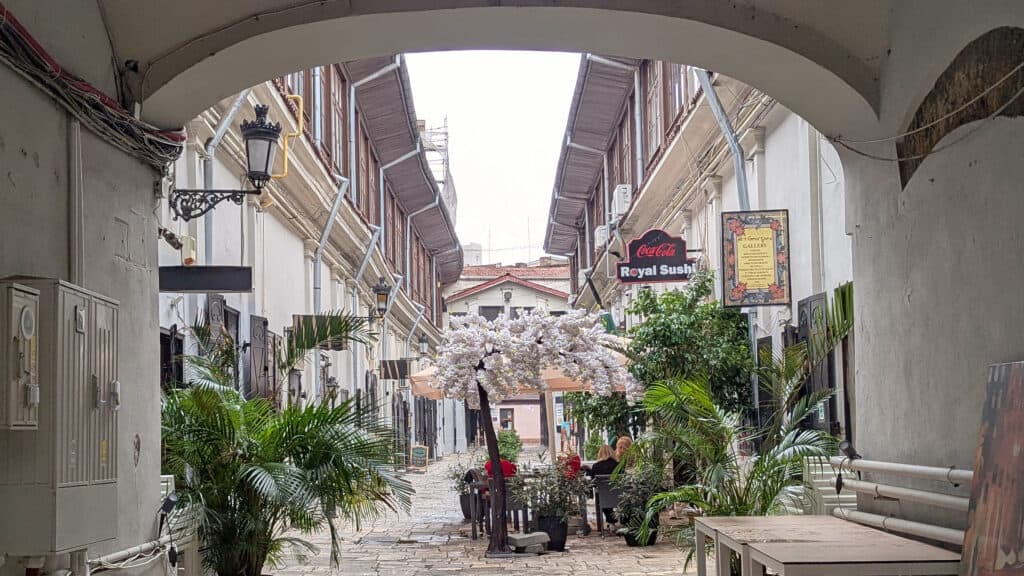
Today it’s a peaceful courtyard reached through narrow passageways, lined with art galleries, craft shops and cafes.
Bars and Craft Ale
Nightlife and bars are one of the Old Town’s most obvious attractions. There’s no shortage of places for a bar crawl in Centru Vechi, and the Nomad Skybar is especially popular, with a great rooftop view over the Old Town.
If you’re a craft beer fan like me, you’re in for a treat. Romania’s craft beer scene began in Bucharest, and the Ground Zero Taproom in the Old Town is the perfect place to start. Each bar has its own personality and serves beers from independent Romanian breweries you won’t find elsewhere. For a full rundown of Bucharest’s craft ale offerings, I’ll refer you to my husband, who bought me all the beers – I just drank them.
Van Gogh Café
Just off Strada Smârdan, Van Gogh Café is one of the Old Town’s loveliest and most Instagrammable spots. Housed in a restored 19th-century building, it’s bright and airy inside with large windows overlooking the square – and service that’s a notch above many nearby places.
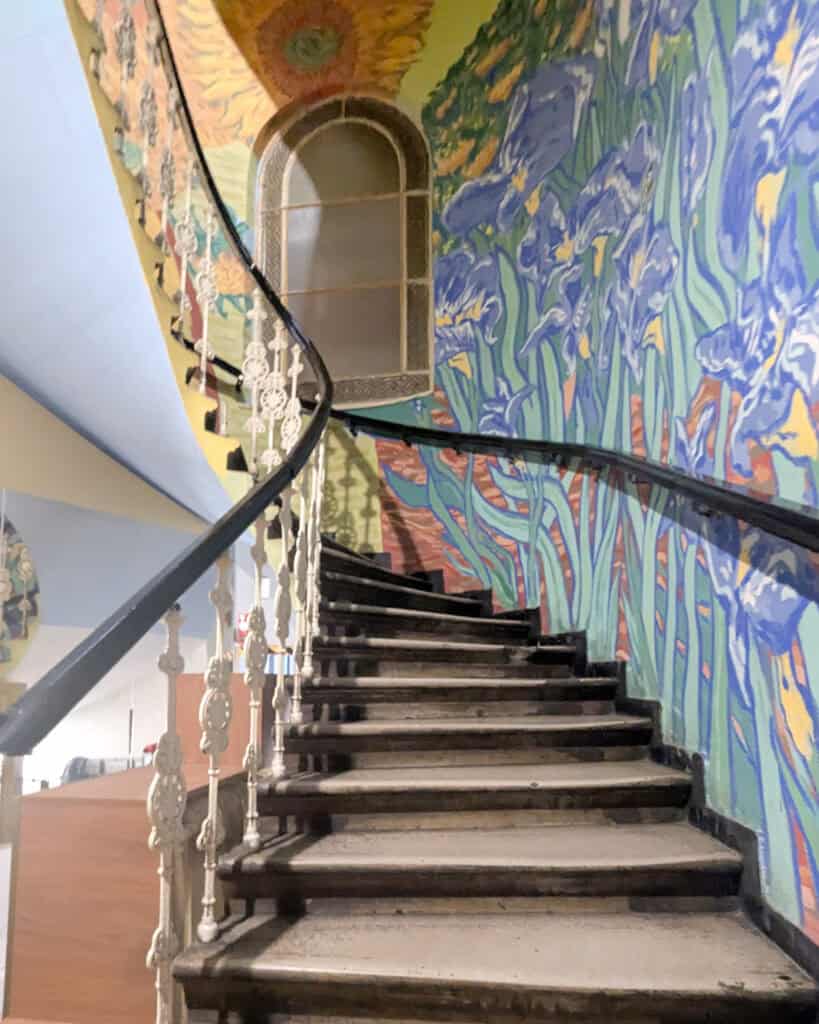
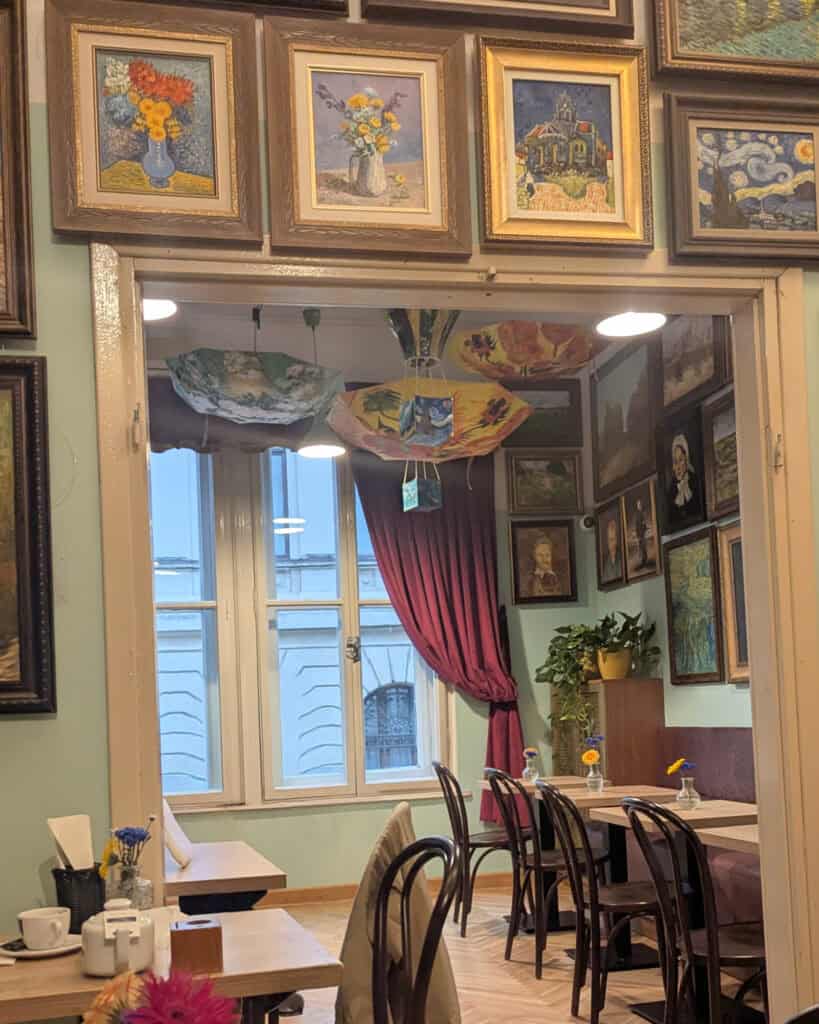

We shared a papanasi here (Romania’s signature doughnut topped with cream and jam), which was as indulgent as it sounds. Come mid-morning for coffee or late afternoon for dessert or pick an evening spot, like we did, to avoid the crowds.
Stavropoleos Monastery
Amid the chaos of Centru Vechi, the tiny Stavropoleos Monastery feels almost hidden in plain sight. Built in 1724, this Eastern Orthodox church is one of the most beautiful in the city, with delicate stonework, painted frescoes, and a serene courtyard garden. Step inside, to see a beautifully preserved Orthodox interior.
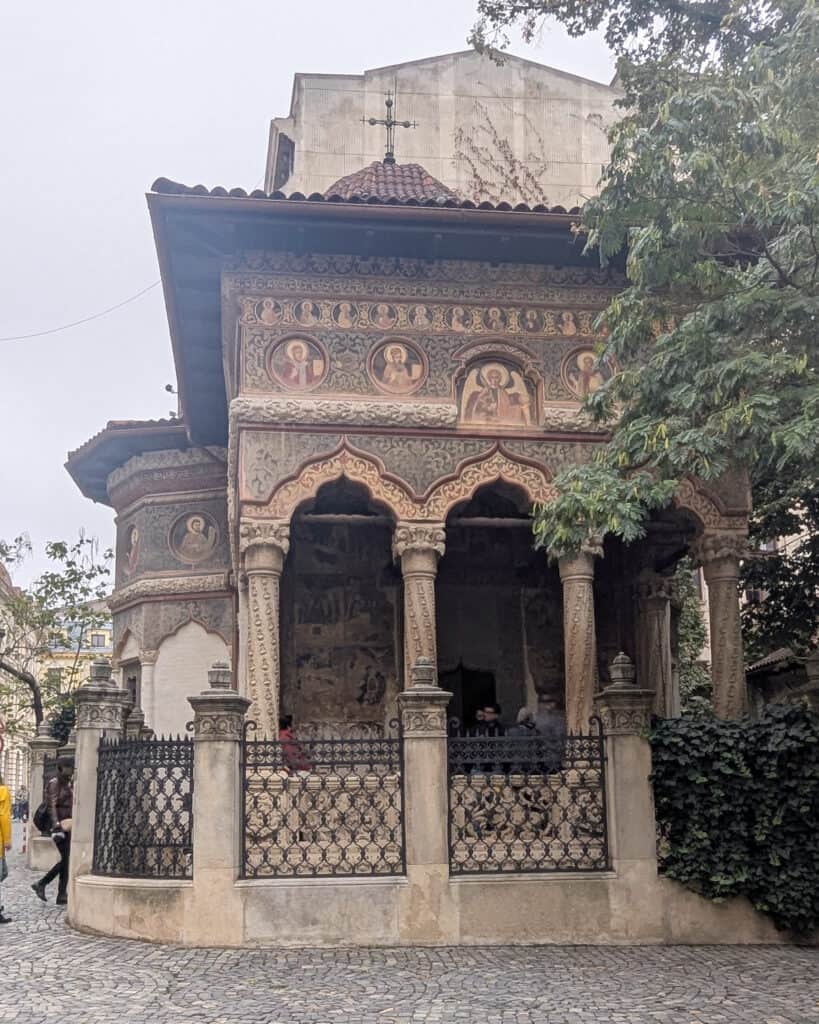

The Old Princely Court – Vlad’s Bucharest
The Old Princely Court (Curtea Veche) was once the seat of Vlad Țepeș – better known as Vlad the Impaler, the man who inspired the Dracula legend. Though currently boarded up for restoration, it’s worth a short detour to see the statue of Vlad and what remains of his medieval palace walls, through the fencing.
Manuc’s Inn
Rounding off your Old Town wander, Hanul lui Manuc (Manuc’s Inn) is the oldest operating inn in Bucharest, dating back to 1808. Originally a caravansarai, a merchant’s inn for travellers on the Ottoman trade routes.

The wooden balconies and cobbled courtyard are still its heart, now home to a popular restaurant.
Other Things To Do In Bucharest
So after you’ve learned about Bucharest’s Communist past, spotted some of the glamorous French style buildings and enjoyed the delights of the Old Town, there’s still a few more things to see. So here’s a slightly random list of what’s left.
Bucharest’s Romanian Athenaeum
Even if you’re not a classical music fan, the Romanian Athenaeum (Ateneul Român) is a must-see. The circular concert hall is the pride of the city. We managed to get tickets for a concert here on our first visit to Bucharest and it was quite the experience. If there’s something on, when you visit, I’d definitely try and get tickets.
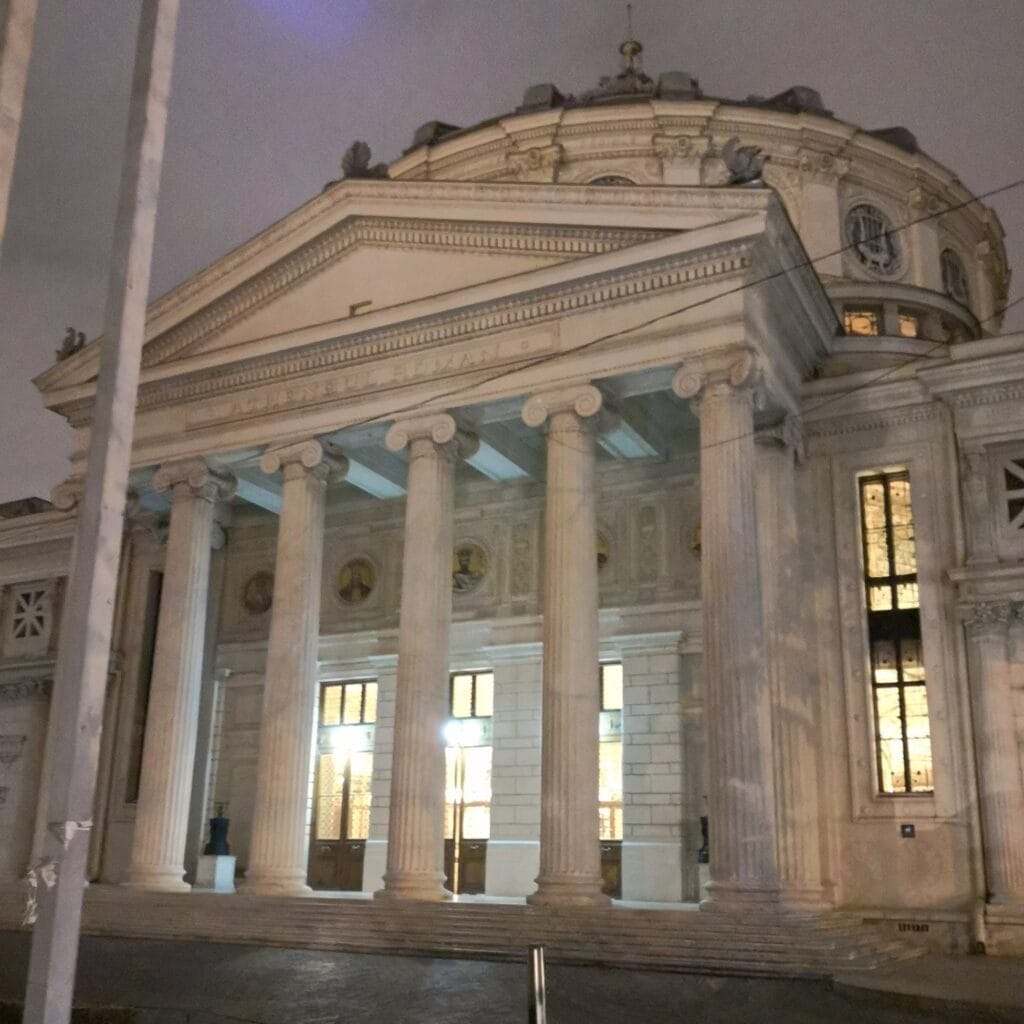
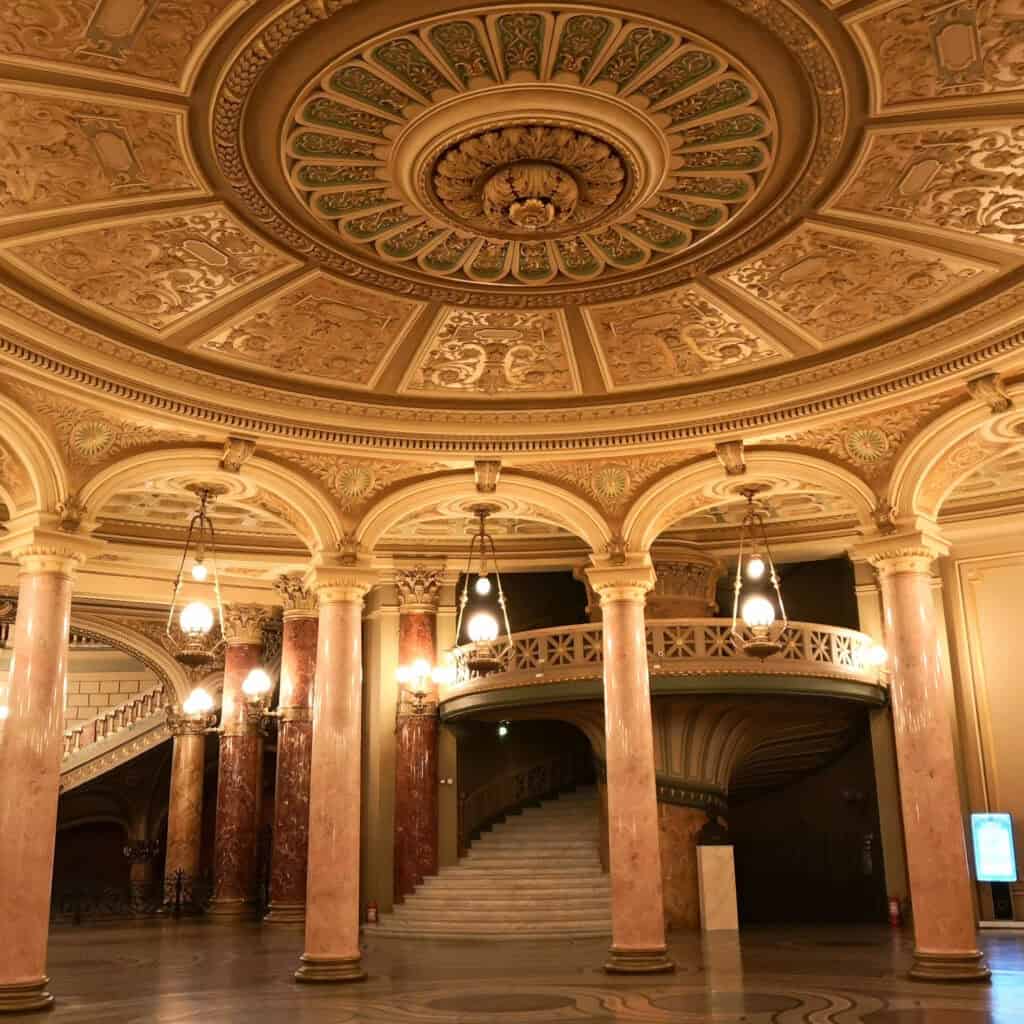
If you can’t get to see a concert, you can go inside as part of a guided tour of the Romanian Athenaeum or you may be able to ask at the entrance too.
Village Museum – Discover Traditional Romania
For something completely different, head to the Dimitrie Gusti National Village Museum, an open-air museum beside King Michael Park.
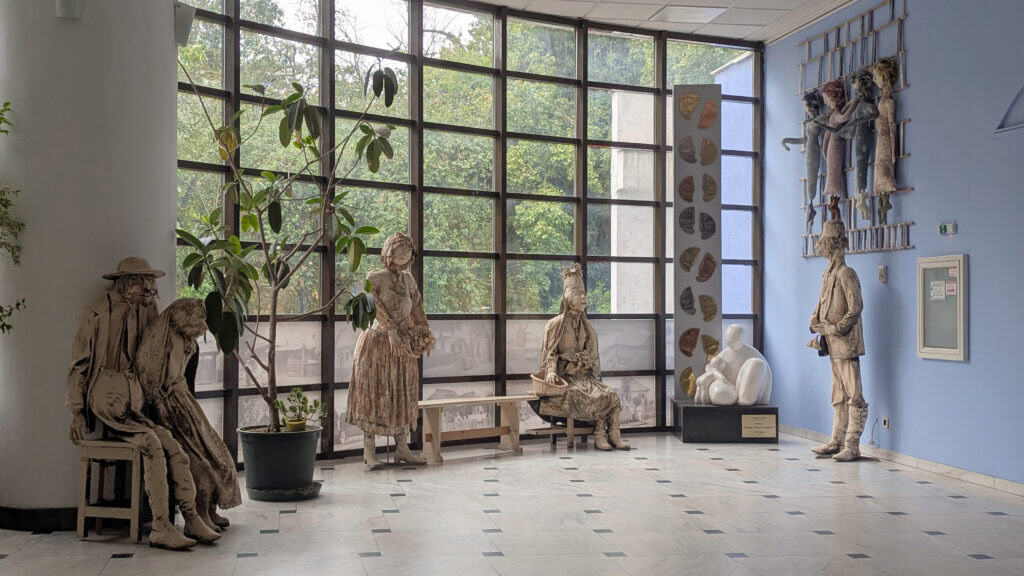
It’s a patchwork of traditional Romanian houses, windmills and wooden churches relocated from across the country.
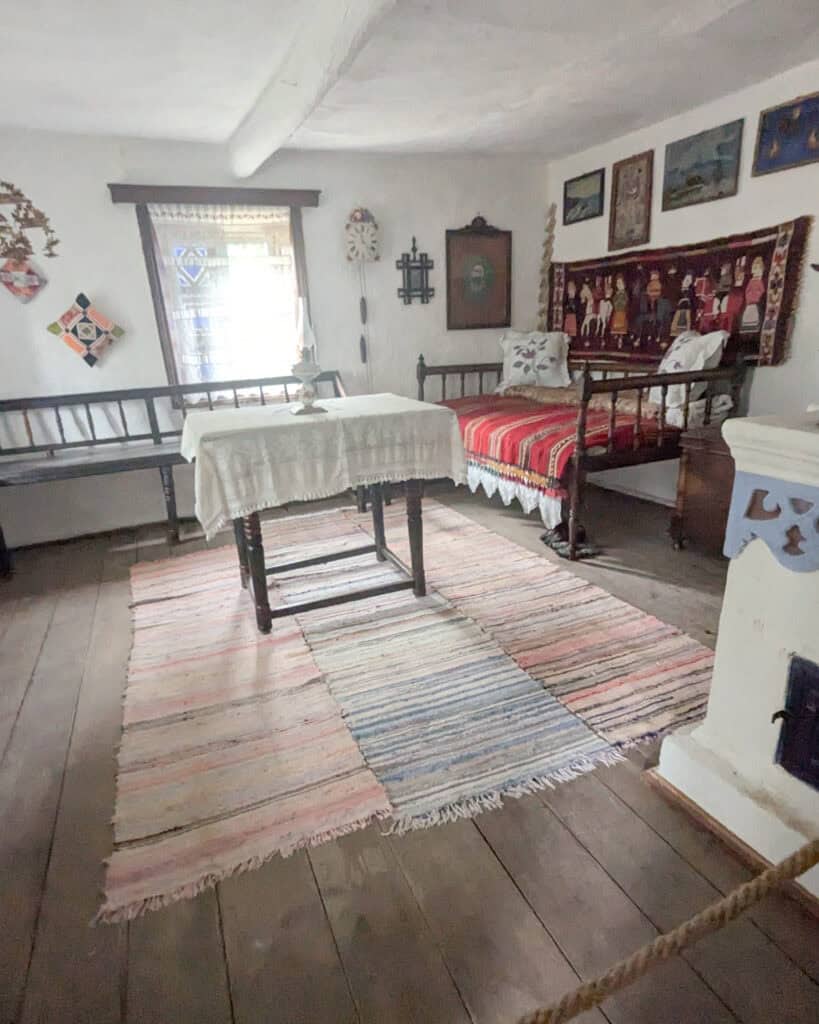
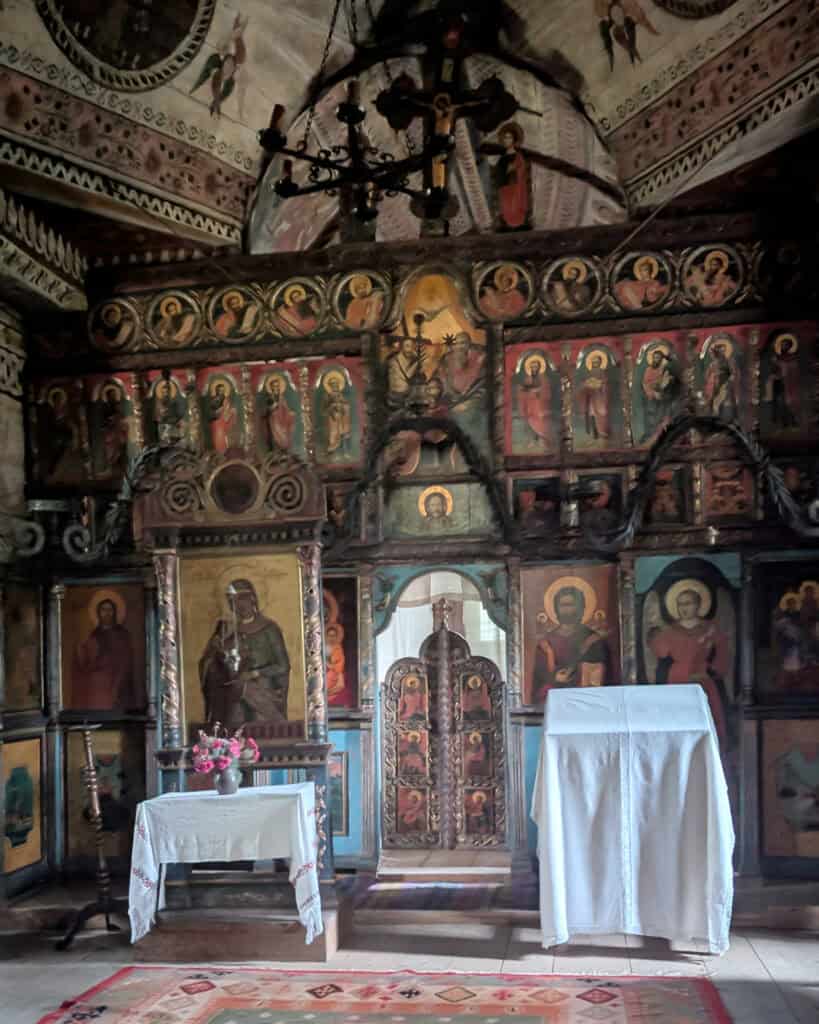
You can wander freely. It’s a peaceful antidote to the city traffic and a glimpse of rural Romania without leaving Bucharest. It decided to absolutely bucket down with rain when we went, so we didn’t linger too long between buildings!
The Orthodox Cathedral and More Churches
You’ve probably seen a few of Bucharest’s most famous churches already, but there are dozens more tucked between apartment blocks or hidden in quiet corners.
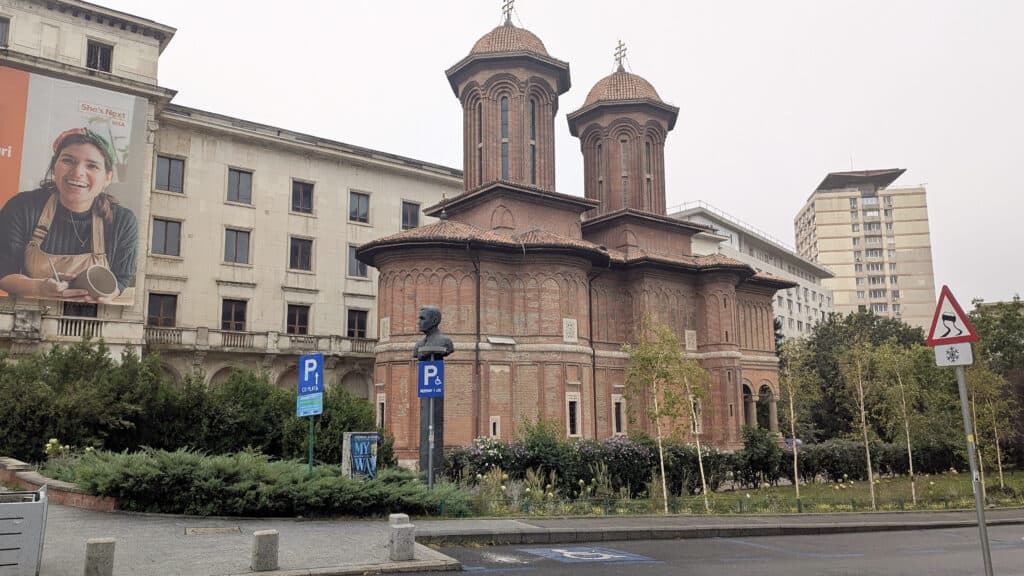
These are some we visited or snapped from the outside.
- St George Plevna,
- New Saint Eleftherius, Zlătari Church (on Calea Victoriei)
- Saint Demetrius
- Saint Anthony
The monumental Cathedral of National Salvation (Catedrala Mântuirii Neamului) is still under construction – its vast size and golden dome dominate the skyline. You’ll spot it as you pass the Palace of the Parliament.
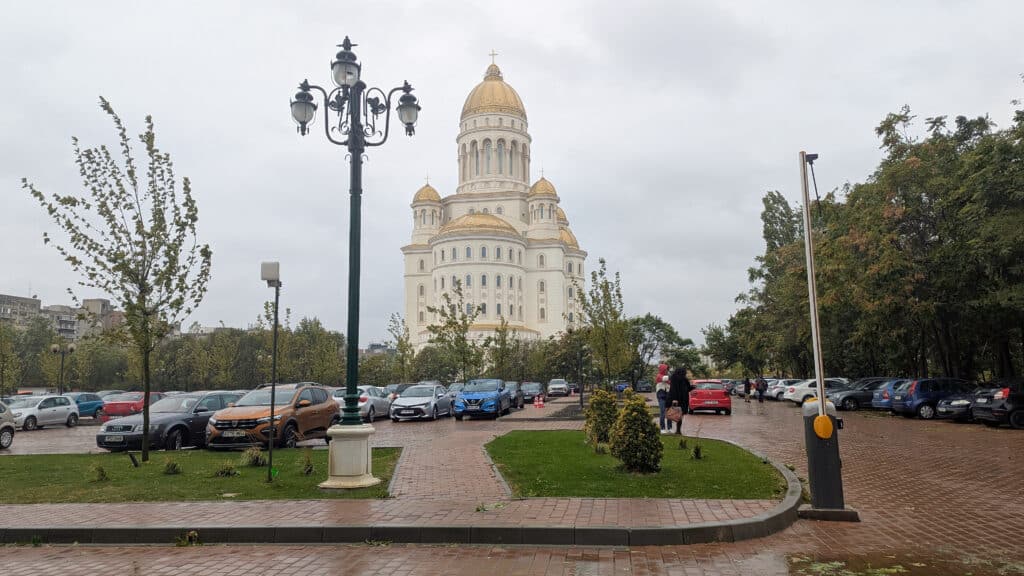
Dorobanți District
For a more authentic feel, head to the Dorobanți district, one of Bucharest’s smartest suburbs. It’s relaxed, residential and full of good cafés and smart shops.
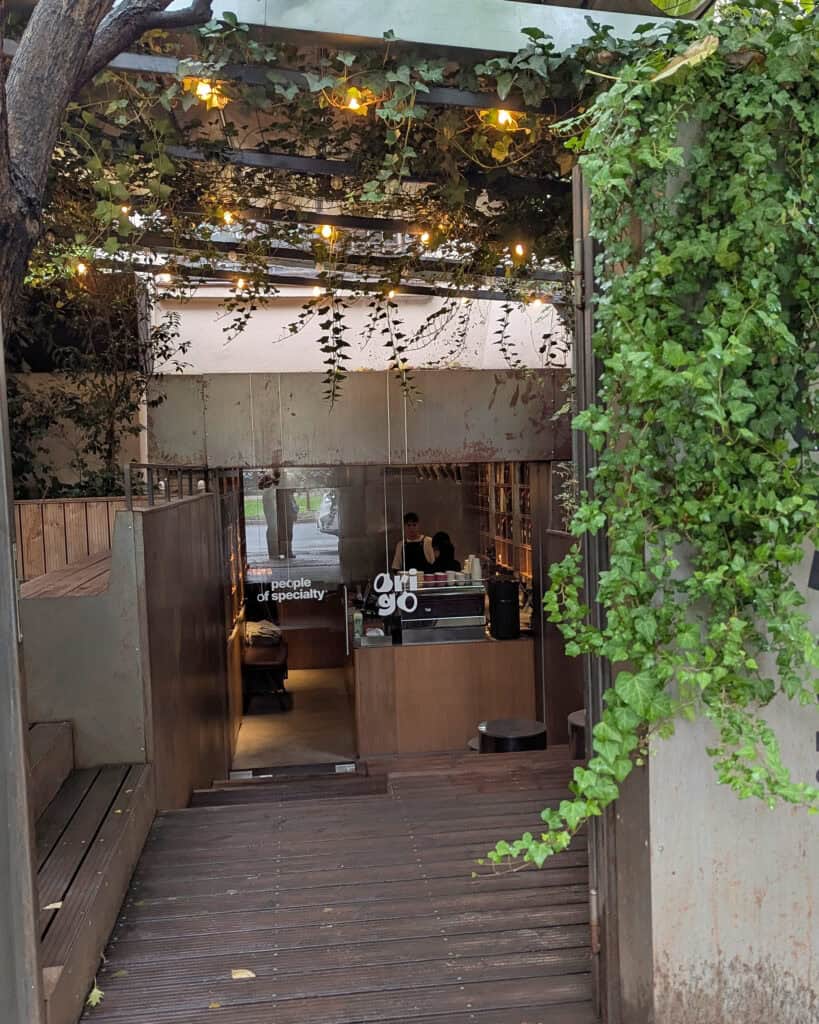

Our favourite stops were Paul (yes, the French chain – but excellent here) and Origo, which roasts its own beans. The district is an easy walk from the Arc de Triumf and King Michael Park, so it works well as a morning coffee stop before exploring the north of the city.
Bucharest’s Parks – Green Spaces in the City
When the weather’s good, Bucharest lives outdoors. We found outdoor vending machines with quality ground coffee and freshly squeezed orange juice (how civilised?) as well as beautiful green spaces and plenty of statues.
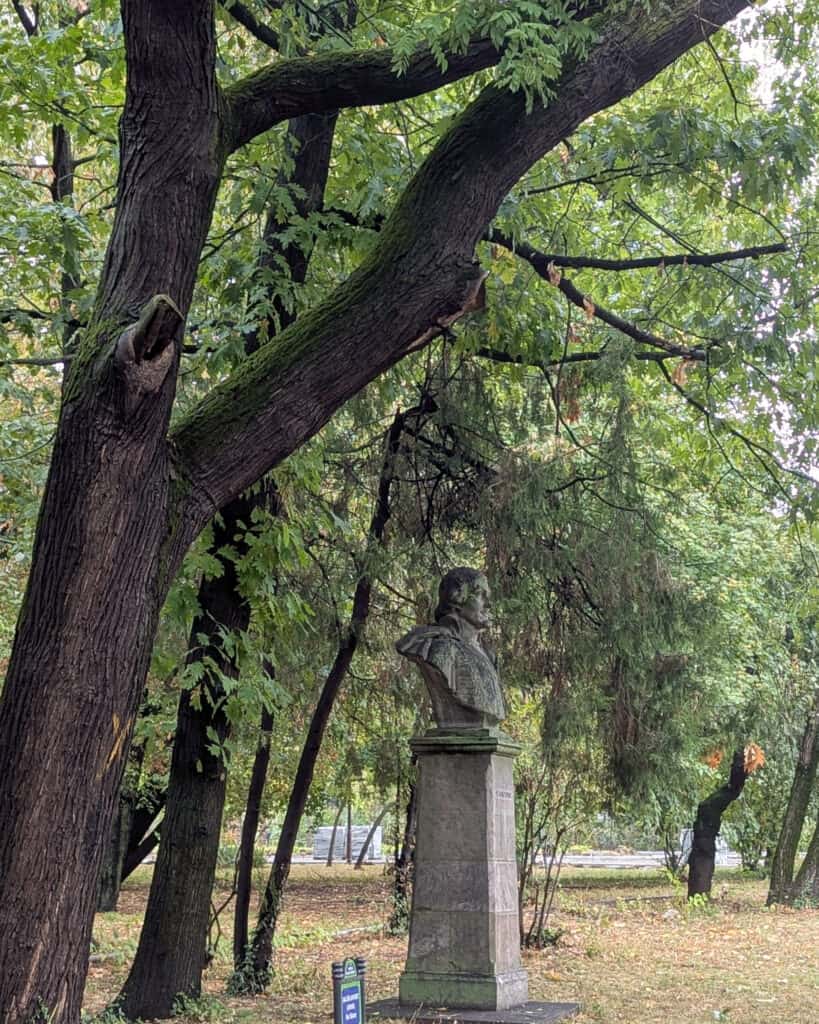

Here’s a couple we found heading north from the city centre.
- Herăstrău Park (King Michael I Park) – the largest park in Bucharest and a great place to walk, cycle or people-watch. Scattered through the greenery are statues of Romania’s cultural icons. We spotted Shakespeare, Mihai Eminescu, and even Michael Jackson, whose 1992 concert here made quite the impression. You’ll also find lakeside cafés and boat rentals in summer. Stop here if you’re visiting the Arc de Triumf, the Village Museum, or the Dorobanți District and let the M2 metro take you to Aviatorilor to save your legs.
- Parcul Kiseleff – linking the Arcul de Triumf area with the city centre, another leafy area worth visiting. There was a busy festival with music and lots of food stalls when we passed through.
Markets – Everyday Bucharest
Markets are one of the best ways to see daily life up close. The well known ones which are often recommended are Amzei Market (Piața Amzei) and Obor Market are often recommended. We found the Muzeul Țăranului Târg (Peasant Museum Market), which pops up on weekends around a small wooden church in the courtyard of the National Museum of the Romanian Peasant, near the Museum of Natural History. Lots of handmade crafts and local snacks. I love the juxta-position of the modern buildings, the ancient wooden church, the wall mural and market stalls.
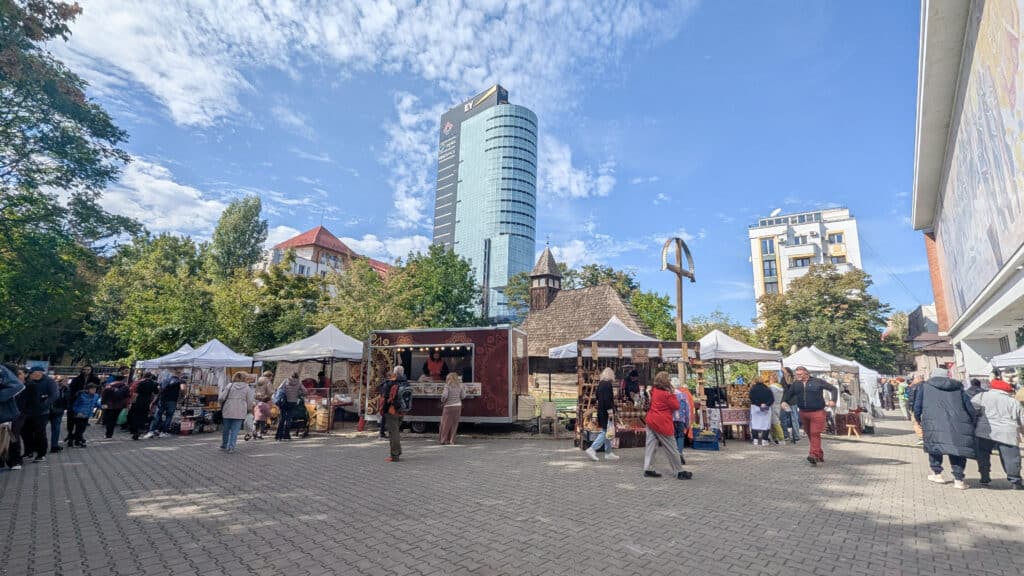
And One To Avoid Right Now
Piața Unirii – Currently Under Construction
Every city has a spot that’s better skipped, and in Bucharest it’s Piața Unirii right now. Once home to a spectacular fountain display, most of the square has been dug up for long-term renovation and currently offers more dust and fencing than charm. You’re better off heading elsewhere, for the time being.
Getting around Bucharest
Bucharest is a big city but surprisingly easy to navigate. The metro is fast, cheap and reliable, with four main lines. The M2 (north–south) is the one you’ll use most for tourist sights.
Contactless cards work directly at the gates, so there’s no need for paper tickets. Buses, trams and trolleybuses fill in the gaps, though routes can be confusing; Use Rome2Rio or Citymapper. Google Maps or the Moovit app can be particularly useful for live info. Taxis and Bolt are inexpensive, but traffic can be slow at rush hour, so the metro often wins.
Group Tours and Day Trips from Bucharest
Once you’ve explored Bucharest’s boulevards, coffee spots and hidden corners, it’s worth venturing a little further. The capital is perfectly placed for easy day trips, from fairy-tale castles in the Carpathians to the breezy Black Sea coast.
The most popular routes include Sinaia and Peleș Castle, Brașov’s colourful old town, and Constanța by the sea, but there are other options too, including cross-border trips.
I’ve covered them all in detail in my dedicated guide: Best Day Trips from Bucharest: Castles, Mountains, the Black Sea and Cross Border Adventures, complete with travel tips, routes, and honest recommendations.
If you are thinking of heading over the border into Moldova, do check out my guide to riding the Prietenia Sleeper Train which runs between Bucharest and Chisinau, the capital of Moldova. Or if you’d rather cross the border by road, then do consider going via the Eastern Romanian gem of a city, Iasi.
I’ll be adding more posts soon from my recent travels around Romania. If you’d like a monthly update do subscribe to hear when new guides go live. Don’t worry, I won’t bombard you, I’ll typically email once a month.
Thanks for Reading. And still curious? Here’s some top posts from the One Small Bag blog.
-
Transnistria Day Trip from Chișinău – Worth It?
Part Soviet time capsule, part breakaway state – here’s what I found on a surreal day trip to Transnistria
-
Lightweight Tech for Travel: What to Pack and What to Skip
While we want to capture every moment, stay connected, and maybe squeeze in some remote work, it’s easy for tech…
-
Best Things to Do in San Marino (and Why You’ll Want to Stay for Sunset)
San Marino is the third smallest country in Europe and proudly calls itself the world’s oldest surviving republic. Perched high…